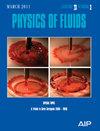受地磁风暴调制的地球辐射带高能质子通量和俯仰角分布的可变性
IF 4.1
2区 工程技术
Q1 MECHANICS
引用次数: 0
摘要
作为环流系统的重要组成部分,被困在辐射带中的高能质子在观测和理论上都会受到地磁扰动的影响。利用范艾伦探测器的观测数据,我们统计分析了它们在 55-489 千伏的时间变化以及它们的俯仰角分布(PADs)指数 n(用 sinn∂ 拟合,其中 ∂ 是俯仰角)对地磁暴的响应。它表明,在风暴期间,低能量的质子更容易被加速。高能量质子的加速阈值变得更大,而较大的 n 值可以持续几天到几个月。进一步的研究表明,四分之一的风暴会增加质点位置(Lpp)内外所有能量通道(55-489 keV)的质子通量。具体地说,超过一半的风暴会提高质点位置内部和附近 Ek > 400 千伏的质子通量,以及质点位置深处 Ek < 100 千伏的质子通量。在75%的日侧风暴中,指数n在L > 5时优先减小,而在50%的夜侧风暴中,指数n在L = ∼ 4时减小,表现出明显的昼夜不对称。进一步的详细研究表明,包括径向扩散、磁极阴影和波粒相互作用在内的源和损耗过程是造成统计结果的原因。本研究提供了关于高能质子通量总体特征的定量信息,有助于加深对辐射带的理解。本文章由计算机程序翻译,如有差异,请以英文原文为准。
Variability of energetic proton flux and pitch angle distributions in the Earth's radiation belt modulated by geomagnetic storms
Energetic protons trapped in the radiation belt, as a vital component of the ring current system, are observationally and theoretically modulated by geomagnetic disturbances. Utilizing Van Allen Probe observations, we statistically analyzed their temporal variations at 55–489 keV as well as their pitch angle distributions (PADs) index n (fitted by sinn∂, where ∂ is the pitch angle) in response to geomagnetic storms. It shows that protons at low energies are more easily accelerated during storms. The threshold of accelerations becomes greater for high-energy protons, while a large value of n can persist for a few days to months. Further investigations suggest that one-quarter of the storms increase the proton flux at all energy channels (55–489 keV) both inside and outside the plasmapause location (Lpp). Specifically, more than half of the storms enhance the flux for protons at Ek > 400 keV inside and close to the Lpp as well as protons at Ek < 100 keV deep inside the Lpp. Comparably, protons at larger pitch angles (near 90°) are more easily lost outside the Lpp, which results in more pronounced pancake PADs with larger n. The index n preferentially decreases at L > 5 during 75% of the storms on the dayside, while it decreases at L = ∼4 during 50% of the storms on the nightside, showing significant day–night asymmetry. Further detailed investigations revealed that source and loss processes, including radial diffusion, magnetopause shadowing, and wave–particle interactions, account for the statistical results. The present study provides quantitative information on the overall characteristics of energetic proton fluxes, which can enhance the comprehension of the radiation belts.
求助全文
通过发布文献求助,成功后即可免费获取论文全文。
去求助
来源期刊

Physics of Fluids
物理-力学
CiteScore
6.50
自引率
41.30%
发文量
2063
审稿时长
2.6 months
期刊介绍:
Physics of Fluids (PoF) is a preeminent journal devoted to publishing original theoretical, computational, and experimental contributions to the understanding of the dynamics of gases, liquids, and complex or multiphase fluids. Topics published in PoF are diverse and reflect the most important subjects in fluid dynamics, including, but not limited to:
-Acoustics
-Aerospace and aeronautical flow
-Astrophysical flow
-Biofluid mechanics
-Cavitation and cavitating flows
-Combustion flows
-Complex fluids
-Compressible flow
-Computational fluid dynamics
-Contact lines
-Continuum mechanics
-Convection
-Cryogenic flow
-Droplets
-Electrical and magnetic effects in fluid flow
-Foam, bubble, and film mechanics
-Flow control
-Flow instability and transition
-Flow orientation and anisotropy
-Flows with other transport phenomena
-Flows with complex boundary conditions
-Flow visualization
-Fluid mechanics
-Fluid physical properties
-Fluid–structure interactions
-Free surface flows
-Geophysical flow
-Interfacial flow
-Knudsen flow
-Laminar flow
-Liquid crystals
-Mathematics of fluids
-Micro- and nanofluid mechanics
-Mixing
-Molecular theory
-Nanofluidics
-Particulate, multiphase, and granular flow
-Processing flows
-Relativistic fluid mechanics
-Rotating flows
-Shock wave phenomena
-Soft matter
-Stratified flows
-Supercritical fluids
-Superfluidity
-Thermodynamics of flow systems
-Transonic flow
-Turbulent flow
-Viscous and non-Newtonian flow
-Viscoelasticity
-Vortex dynamics
-Waves
 求助内容:
求助内容: 应助结果提醒方式:
应助结果提醒方式:


